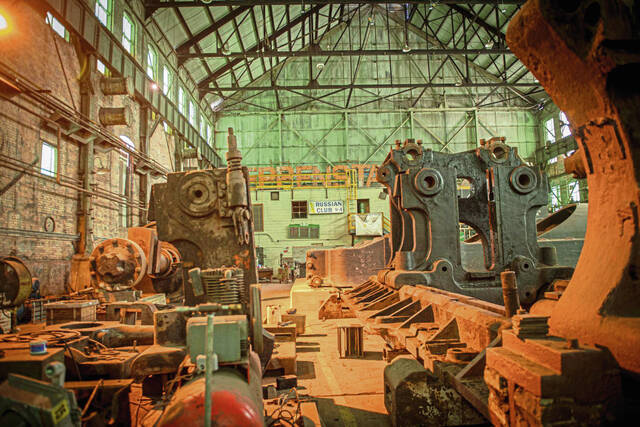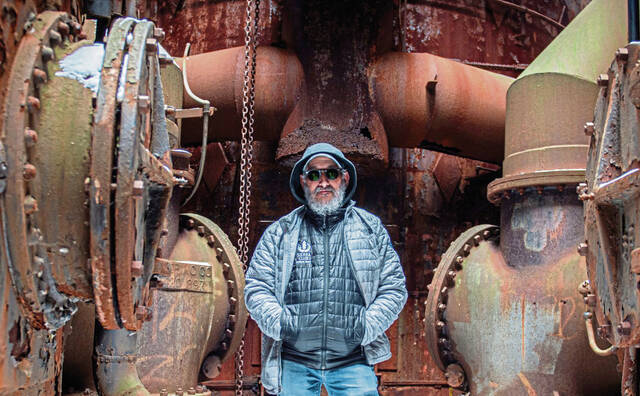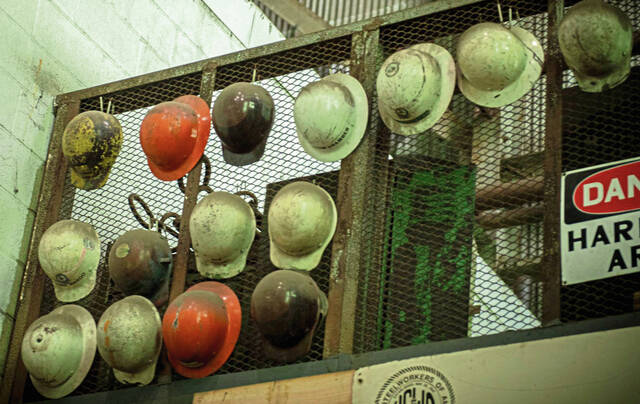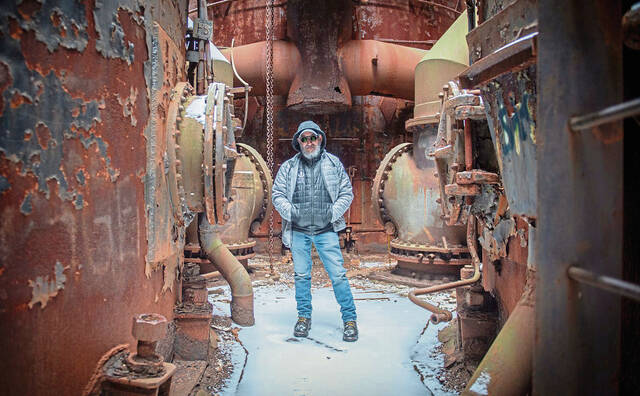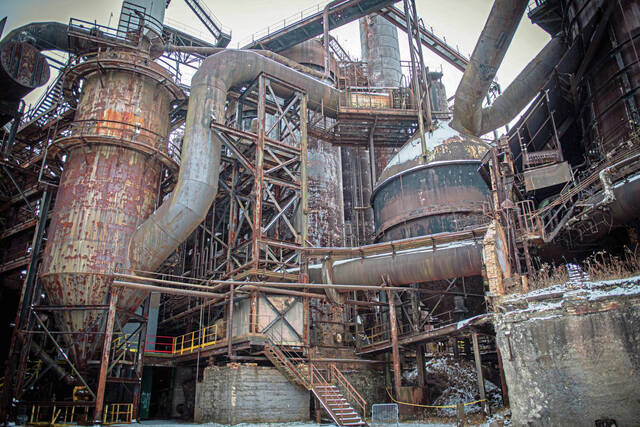'Steel is all around us:' Despite uncertain future locally, U.S. Steel’s connection to this region and its people endures
President Joe Biden’s decision to thwart a Japanese firm from buying U.S. Steel doesn’t pen an obituary for the Pittsburgh-based industrial titan whose decades-long fall from grace has been inextricably linked to the city where it was born.
But it does portend an uncertain future for an industry that built modern America and minted Pittsburgh as the Steel City and its football heroes as the Steelers. It leaves fingerprints on capitalism, economic trends and environmental legacies — and even how the world views those who call Pittsburgh home.
“If you go back 100 years, this was one of the industrial centers of the United States, of the world,” said David Jardini, 61, of Sewickley, a businessman who teaches a course on Pittsburgh steel at Carnegie Mellon University.
“Steel is all around us. It’s part of our nervous system. It’s part of our DNA,” he added. “And even if the industry goes away, steel will still be embedded for generations in the tissue of Pittsburgh.”
Though a British fort built in the 1750s at the forked confluence of three rivers triggered Colonial development, Pittsburgh figuratively was born more than a century later in the explosions of steel mill blast furnaces.
Appalachia’s industrial mecca, where widespread manufacturing pollution sometimes led officials to flip on Downtown streetlamps at noon, coalesced in the public mind through “Hell with the lid off” caricatures that captured the boundless spirit of the Industrial Revolution.
Industrialist Andrew Carnegie seized on that energy, helping to consolidate several Pittsburgh firms into U.S. Steel in 1901. It quickly began its reign as the world’s largest corporation.
Within 20 years of U.S. Steel’s christening, Pittsburgh mills were producing one-third of the steel made in all of the U.S. By the 1950s, they were making half of it.
At a 1953 peak, U.S. Steel mills churned out 35 million tons of steel a year — roughly enough to build 800 copies of the U.S. Steel Tower, the company’s iconic Downtown headquarters and the tallest skyscraper between New York City and Chicago.
Metal from U.S. Steel was used locally — the three Sister Bridges — but also in structures like the San Francisco-Oakland Bay Bridge. It constructed the New Orleans Superdome. It also formed the United Nations Building in New York — and the Empire State Building.
Pittsburghers know where the storyline went next.
As American businesses started importing more steel than U.S. mills made, priorities shifted. Detroit’s automotive industry — Big Steel’s top customer — started using lighter materials. Beer and soda pop manufacturers swapped the steel in their cans for aluminum.
Related:
• Devastation, relief on spectrum of emotions for stakeholders in U.S. Steel sale after Biden's block
• U.S. Steel, Nippon say Biden's decision to block sale was 'political'
• With U.S. Steel deal axed, economic experts question future of Mon Valley steelmaking
• What they're saying about it: U.S. Steel-Nippon deal blocked
“If the consumer prefers an aluminum can or a plastic bottle, a glass bottle, that’s not reversible — and it’s not the place of the government to intervene,” said steel analyst John Tumazos, 68, of Titusville, Fla., who grew up in Wilkinsburg while his father built a 27-year career at Homestead Works.
“So the steel business has shrunk over the last half-century,” he added. “U.S. Steel is no longer what it was in 1901 — or even what it was in 1960.”
Then, steel companies started shuttering American mills.
U.S. Steel shut down operations in Worcester, Mass., in 1977, then three years later in Youngstown, Ohio. The company closed the Duquesne Works in 1984. The mighty Homestead Works — for many years the largest steel mill in the world — went dormant in 1986.
In 1953, some 650,000 Americans worked in the steel industry, according to the American Iron and Steel Institute. By 1984, the number had plummeted to 236,000. And that’s only including those who worked in the steel industry. Countless other jobs and workers supporting the industry, from 24-hour diners and bars to supermarkets and schools, were impacted.
Today, U.S. Steel employs about 3,000 people in all of Pennsylvania.
As jobs evaporated, cities joined what some call the Rust Belt. Residents fled, too. Pittsburgh’s contracting population was cut in half, dropping from 604,000 in 1960 to 302,000 in 2020.
More than 400 factories once packed the “Pittsburgh industrial district,” which stretched from Aliquippa on the Ohio River in the west, to the Alle-Kiski Valley in the northeast, to Monessen in the southeast, said Ron Baraff, director of historic resources and facilities for the nonprofit group Rivers of Steel.
“From Downtown Pittsburgh to 22 miles down the Mon, it looked like one continuous mill,” Baraff said.
Today, the region boasts just one or two dozen steelmakers, he said.
“I still miss driving down the parkway and seeing the big J&L stacks working,” said Tony Buba, 81, of Braddock Hills, an award-winning filmmaker whose best-known works have documented life around the steel mills.
Buba says artists long have been drawn to Pittsburgh industry — the mills’ interplay of light and darkness, the juxtaposition of small men and giant machines.
“I’ve seen the Grand Canyon, sure, but it was nothing compared to the mills,” Buba said. “There was something about them. They were massive. And there was a kind of romanticism to them.”
A tour inside Carrie Furnace
Baraff sported multiple layers of clothing and a well-worn Homestead Grays baseball cap Saturday morning as he entered the ruins of a shuttered steel mill.
The native Pittsburgher, who boomeranged back to the city in 1997 after living in Washington and Oregon, traced the character of Pittsburghers — even the yinzer stereotypes some embrace — to the rusty remains of Carrie Furnaces.
For Baraff and others who spoke with TribLive, Pittsburgh’s characterization as a hardworking, salt-of-the-earth city of neighbors is rooted in the work ethic once required to toil through 12-hour shifts, six days a week, in mills such as Carrie Furnaces.
“There’s a reason why it was called ‘the Pittsburgh spirit,’ ” said Baraff, 61, of Bellevue, as he navigated down a set of snow-covered mill steps. “Yeah, some of that’s marketing. But there’s also something behind it. When you meet someone, you know they’re a Pittsburgher. The whole blue-collar Steelers-grit thing? There’s something to it.”
The mill, which produced iron for the massive 420-acre Homestead Works that ran along 4 miles of Monongahela River banks, opened in 1884 and closed in 1982. The site became a national landmark in 2006.
On Saturday, Baraff paused as he gestured toward one of the site’s towering furnaces.
“This is a man-made volcano,” he laughed.
A hot stove’s checker-brick interior literally would glow as it heated to 1,800 degrees Fahrenheit. After moving to the blast furnace, heated liquid metal and some impurities — old-timers called them “cinder,” he said — then cooked to 2,800 degrees Fahrenheit before pouring down channels of sand-lined runners.
“These guys were taming a dragon. This was a fire-breathing dragon,” Baraff said. “And if you didn’t know how to do it right, how to work with it, you were in danger. And those around you were in danger.”
“It’s not hyperbole to say places like this built the modern world,” he added.
“Andrew Carnegie? Sure. But this is the other side of the American Dream: being exposed to hell to help your family. That’s why these places matter. In the end, it’s a human story.”
From steel, to ‘eds and meds,’ to …
David Jardini said he has heard a familiar refrain from young Carnegie Mellon University undergrads new to Western Pennsylvania when they’d ask him about the class on Pittsburgh steel Jardini has taught on and off for 15 years.
“ ‘I hear all this stuff about the Steelers, about the Steel City,’ they tell me,” Jardini laughed. “ ‘I don’t see that,’ they say. ‘Where is it?’ ”
In the decades since many fled Pittsburgh amid closing mills, an “eds and meds” economy took over. Today, Pittsburgh is home to tech icons such as Duolingo.
More than 28,000 people work at the University of Pittsburgh, whose main campus consumes the city’s Oakland neighborhood.
And the logo atop the U.S. Steel Tower has forgone steel. Now it promotes UPMC, the health care giant that has grown into the state’s largest non-governmental employer.
Those taking Jardini’s spring-semester class, from which Jardini is taking a break in 2025, learn the ABCs of the past and of Pittsburgh’s industrial roots.
Jardini traces Pennsylvania’s prevalence of coal deposits and how the fuel fed the industrial beasts. He outlines mass-production trends at the Edgar Thomson Works — the Braddock steel mill whose 1875 baptism pre-dates U.S. Steel, which today still employs about 900 people there.
He also breaks the class into categories. Pittsburgh as a frontier city. Pittsburgh as a gateway to the West. Pittsburgh as a manufacturing center.
The last two ring familiar to Jardini, who grew up in Brentwood in the 1970s as the steel industry constricted locally.
“Sixty years of stagnation and decline,” he said.
Then, simply: “Collapse.”
Best chance lost?
Jardini said he is hesitant to predict U.S. Steel’s next move in Pittsburgh.
But he does believe Nippon Steel, the world’s fourth-largest steel manufacturer and the Japanese firm whose nearly $15 billion deal courted U.S. Steel, represented the region’s best chance at seeing capital investment — and a brighter economic future — for the Mon Valley.
“All the branding and stuff? That’s part of how we remember the steel industry and how it relates to us,” Jardini said. “And the Rooneys” — the family that owns the Steelers’ NFL franchise — “do a very good job at honoring that. They’ll never change the team’s name. And that’s because it’s who we are.”
“But the Mon Valley sites? It was about keeping those jobs, it was about keeping those investments. And that should be at the front of everyone’s minds right now.”
Some see different legacy
Matthew Mehalik thinks U.S. Steel will leave behind a different legacy in Pittsburgh.
For the executive director of the Pittsburgh-based environmental group Breathe Project, it’s less about steel tonnage and more about asthma in Clairton, home to a U.S. Steel mill that is the largest coke-manufacturing facility in North America.
A 2020 study showed outdoor air pollution has contributed to more than 1 in 5 Clairton children developing asthma — a rate three times higher than the national average.
In 2013, a University of Pittsburgh report on air pollution identified coke oven emissions as one of the “top cancer drivers” in the Pittsburgh region.
“Our county is in the top 1% of all counties nationwide for cancer risk from air pollution,” Mehalik, 54, of Richland Township told TribLive. “That’s a difficult part of the narrative, and it’s part of the region’s legacy.
“We celebrate the building, the production — but we don’t want to talk about the human cost that comes along with it,” he added. “And that’s not sustainable.”
In light of Biden’s move Friday to block the U.S. Steel/Nippon deal, Mehalik believes the Pittsburgh region’s industrial outlook is more unclear than ever.
The son, grandson and great-grandson of steel-industry workers hopes, though, that as steelmakers increasingly shift toward carbon-free production and lighten their reliance on fossil fuels, U.S. Steel follows suit.
“The outcome remains to be seen — we always hope for it,” Mehalik said. “U.S. Steel’s historical behavior does not leave a lot of room for optimism … but their rhetoric is aligned with doing what’s best for the community.”
A surge of capital investment from U.S. Steel could lead to business innovation and environmental improvements, not to mention an employment boom in the Mon Valley, much of which suffers from economic depression and historic disinvestment.
“The current anxious moment we’re experiencing is a direct result of not confronting these issues — and it just cannot continue for 50 more years,” Mehalik said. “Maybe all of this will bring U.S. Steel to the table to do what really needs to be done.”
Justin Vellucci is a TribLive reporter covering crime and public safety in Pittsburgh and Allegheny County. A longtime freelance journalist and former reporter for the Asbury Park (N.J.) Press, he worked as a general assignment reporter at the Trib from 2006 to 2009 and returned in 2022. He can be reached at jvellucci@triblive.com.
Remove the ads from your TribLIVE reading experience but still support the journalists who create the content with TribLIVE Ad-Free.


